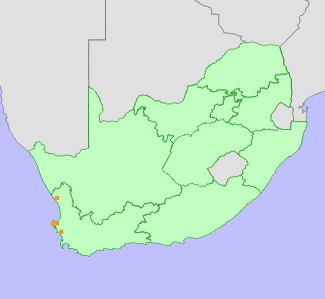|
Scientific Name | Conophytum albiflorum (Rawé) S.A.Hammer |
Higher Classification | Dicotyledons |
Family | AIZOACEAE |
Synonyms | Conophytum edwardsiae Lavis var. albiflorum Rawé |
National Status |
Status and Criteria | Endangered B1ab(v)+2ab(v) |
Assessment Date | 2021/11/08 |
Assessor(s) | A.J. Young, P.G. Desmet, I. Ebrahim, D. Guo, A. Harrower, L. Jabar, L. Knoetze, C. Rodgerson, P.C.V. Van Wyk & N.N. Mhlongo |
Justification | This succulent species is endemic to the Western Cape and Northern Cape province of South Africa where it is only recorded from three, isolated, locations with an extent of occurrence (EOO) of 3,311 km² and an area of occupancy (AOO) of 28 km². This dwarf succulent has been subject to illegal collection in 2020-21 and population is therefore declining. The continued threat of illegal collection remains high with the small, isolated locations and relatively small subpopulation sizes rendering the species susceptible to further decline due to this activity. Species within the genus Conophytum are susceptible to climate change, with models predicting a 63% loss of suitable bioclimatic habitat by 2080 under likely emission scenario RCP 2.6. There has, however, been no observed drought related mortality or loss of vegetation cover where this species is found and as it occurs across several vegetation units it is expected to have a level of resilience to climate change. Thus while model predictions place this species in the category Endangered under criterion A, we have decreased the expected population reduction by 20% to 43% based on the uncertainty of the response given the expected resilience of this species. Given that it is currently known from only two locations and there is decline from illegal collection this species qualifies for listing as Endangered under criterion B1+2. |
Distribution |
Endemism | South African endemic |
Provincial distribution | Western Cape |
Habitat and Ecology |
Major system | Terrestrial |
Major habitats | Succulent Karoo |
Description | This specialist dwarf succulent is primarily restricted to the Fynbos biome (Western Strandveld bioregion) with a disjunct population located further north along the Atlantic coast in the Namaqualand Sandveld bioregion of the Succulent Karoo biome. It has been observed to occupy two niche habitats: on west-facing, sheltered, steep faces of large granite domes (where the plants are highly cryptic as they are typically hidden amongst dense patches of lichen) and also in very shallow grit-filled pans usually on exposed areas of weathered granite. This species has a generation length of 20 years. It is expected to be sensitive to the impacts of climate change as it does not disperse and while adapted to arid conditions, is dependent on limited seasonal rainfall. Species in the genus are sensitive to long periods of drought. Drought related mortality has been observed for other closely related taxa within the genus. |
Threats |
| This succulent is threatened by harvesting for the specialist succulent trade. It is already common in cultivation, however, despite this, it is being subjected to illegal collection. The subpopulations occupy a limited geographic range making the species sensitive to such activity. At the main subpopulation the plants grow in the immediate vicinity of human habitation and amongst farmland, while the second subpopulations is more protected occurring on a private Nature Reserve.
Anthropogenic climate change is a long-term threat to this species. While it is not possible to model the response of this species to climate change due to its restricted distribution, the average loss to climate change for five more widely distributed Conophytum species occurring within the same region is used as an indication of likely impact to this species. Climate models for the likely emission scenarios where emissions stay at present day levels (RCP2.6) (Hausfather and Peters 2020) indicate that there will be a loss of suitable bioclimatic envelope of 63% by 2080 for Conophytum taxa within the region. Species in this genus have limited dispersal ability and migration to suitable habitats elsewhere is regarded as highly unlikely. |
Population |
This species is known from only a few collections, scattered over a wide area. It is possibly overlooked, as parts of its range is botanically still relatively poorly explored, and it is localized to a specialized habitat. Subpopulations are of variable size, ranging from dozens of plants in one locality to locally abundant (over 1,000 plants) in others. The population is currently declining as a result of illegal collection. While illegal collection is suspected to be ongoing this species is not one of the most in demand species, with one subpopulation occurring in an area hard to access, a population decline of between 25 and 40% due to illegal collection is suspected to take place over the next three generations (60 years).
|
Population trend | Decreasing |
Assessment History |
Taxon assessed |
Status and Criteria |
Citation/Red List version | | Conophytum albiflorum (Rawé) S.A.Hammer | Least Concern | Raimondo et al. (2009) | |
Bibliography |
Hammer, S. 2002. Dumpling and his wife: New view of the genus Conophytum. EAE Creative Colour, Norwich.
Hammer, S.A. 1993. The genus Conophytum: A conograph. Succulent Plant Publications, Pretoria.
Hausfather, Z. and Peters, G.P. 2020. Emissions - the 'business as usual' story is misleading. Nature 577(618-620).
|
Citation |
| Young, A.J., Desmet, P.G., Ebrahim, I., Guo, D., Harrower, A., Jabar, L., Knoetze, L., Rodgerson, C., Van Wyk, P.C.V. & Mhlongo, N.N. 2021. Conophytum albiflorum (Rawé) S.A.Hammer. National Assessment: Red List of South African Plants version 2024.1. Accessed on 2025/11/07 |
 Comment on this assessment
Comment on this assessment


